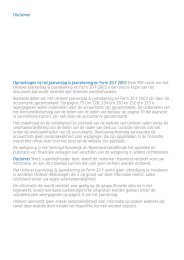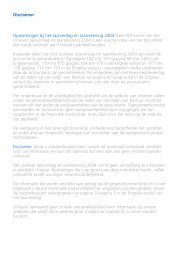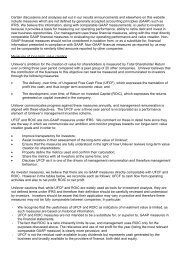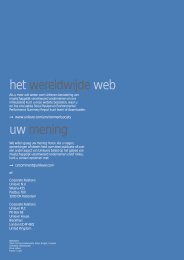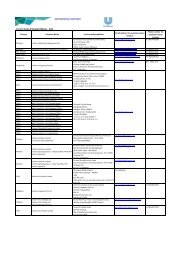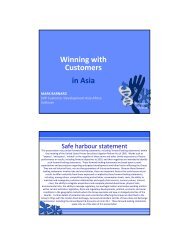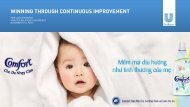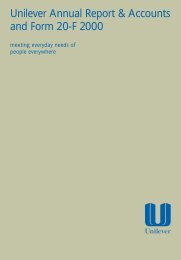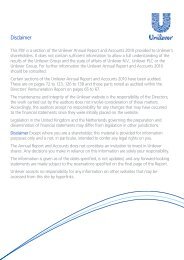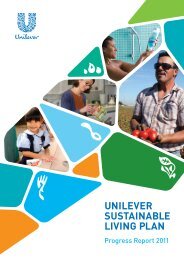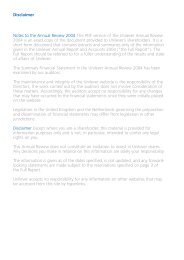Unit Dose - A Sustainability Step for Fabrics Liquids - Unilever
Unit Dose - A Sustainability Step for Fabrics Liquids - Unilever
Unit Dose - A Sustainability Step for Fabrics Liquids - Unilever
You also want an ePaper? Increase the reach of your titles
YUMPU automatically turns print PDFs into web optimized ePapers that Google loves.
ENVIRONMENTAL INDICATORS<br />
USED IN LCA<br />
Global Warming Potential:<br />
emissions of greenhouse gases are<br />
leading to an increased absorption<br />
of radiation emitted by the earth<br />
resulting in global warming.<br />
Contributing emissions include<br />
carbon dioxide, methane and<br />
nitrous oxide and are expressed in<br />
terms of carbon dioxide<br />
equivalence.<br />
Acidification Potential: acid<br />
deposition on soil and water can<br />
lead to detrimental effects on both<br />
flora and fauna. The acidifying<br />
emissions are the oxides of sulphur<br />
and nitrogen oxides that result<br />
from combustion processes.<br />
Photochemical Oxidant Creation<br />
Potential: low-level smog is <strong>for</strong>med<br />
by the reaction of nitrogen oxides<br />
and volatile organic compounds<br />
(VOCs) under the influence of UV<br />
light. Contributing emission<br />
sources include the manufacture of<br />
plastic packaging materials and the<br />
combustion of natural gas.<br />
Nutrification Potential:<br />
the emission of nutrients can lead<br />
to increases in biomass production.<br />
In water, this can lead to algal<br />
blooms resulting in oxygen<br />
depletion that affects higher<br />
species such as fish. Undesirable<br />
shifts in numbers of species can<br />
also occur, resulting in a threat to<br />
biodiversity. Contributing<br />
emissions from the detergent life<br />
cycle are phosphate and<br />
biodegradable materials.<br />
Solid Waste: the sum of all the<br />
sources of solid waste over the<br />
product life cycle. The primary<br />
sources are from mineral-based<br />
raw material sourcing, solid fuel<br />
combustion and packaging<br />
materials.<br />
Energy: the total amount of<br />
primary fuel reserves extracted<br />
from the earth taking into account<br />
the efficiency of electricity<br />
generation and heat producing<br />
processes. This indicator is a basic<br />
measure of resource depletion but<br />
is useful because other indicators<br />
are related to energy.<br />
The examination of the energy<br />
profile can provide valuable<br />
insights into environmental<br />
per<strong>for</strong>mance in general.<br />
<strong>Unilever</strong> Supports Sustainable Development of Detergents with Capsules<br />
TYPICAL IMPACT OF FABRICS WASHING LIQUID BY LIFE CYCLE STAGE (UK data)<br />
Ingredients<br />
Packaging<br />
Comparison with the major laundry<br />
detergent <strong>for</strong>mats in the countries where<br />
we already have capsules, shows that a shift<br />
to capsules generates improvements across<br />
several environmental per<strong>for</strong>mance<br />
indicators. The figures are calculated <strong>for</strong><br />
habits dosages <strong>for</strong> the ‘old’ <strong>for</strong>mats.<br />
These results demonstrate the<br />
environmental advantage <strong>for</strong> capsules<br />
over liquids in <strong>Unilever</strong>’s lead roll out<br />
countries.<br />
Production<br />
Transport<br />
LCA COMPARISON OF UNIT DOSE CAPSULES AND OTHER FORMATS<br />
Use<br />
Disposal<br />
Lever Fabergé Capsules Global Acidification Photochemical Nutrification Solid Waste Energy<br />
vs Other Formats Warming Potential Oxidant Creation Potential<br />
Potential Potential<br />
UK (Liquid)<br />
France (Liquid)*<br />
Netherlands (Liquid)<br />
UK (Std Pdrs)<br />
France (Std Pdrs)<br />
Netherlands (Conc Pdrs)<br />
UK (Tablets)<br />
GWP<br />
Acidification<br />
Potential<br />
POCP<br />
Nutrification<br />
Potential<br />
Solid Waste<br />
Energy<br />
France (Tablets)<br />
Netherlands (Tablets)<br />
0% 20% 40% 60% 80% 100%<br />
* Both standard and concentrated <strong>for</strong>mats<br />
Also, capsules’ environmental position is<br />
generally better than, or at least equal to,<br />
powders and tablets.<br />
Of course, capsules only offer liquids<br />
(bleach-free) per<strong>for</strong>mance levels and this<br />
level of cleaning will not be adequate <strong>for</strong><br />
all users of heavy duty, bleach-containing<br />
powders. However, we do expect many<br />
powders users to be satisfied with the<br />
level of cleaning offered by capsules and<br />
to make the change.<br />
Significant Improvement Significant Worsening No Change



